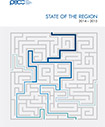Recent Uploads
State of the Region Report 2025-2026
PECC Link E-Newsletter | October 2025
PECC Statement for APEC AMM 2025
PECC Update for APEC CSOM 2025
PECC International Project: Modernizing Digital Trade: Updating the CPTPP's Digital Economy Measures
PECC International Project: ClimateTech in Focus: Innovation for a greener Supply Chain
PECC Signature Project: Opportunities for Supply Chain Decarbonization in APEC Economies

 The Asia-Pacific region is forecast to grow at around 3.8 percent over the next two years before moderating to around 3.5 percent in 2018-2019. While far from the heady rates of above 5 percent growth during the pre-Global Economic Crisis period it represents a steady if unremarkable recovery from the depths of dark days of the 2008-2009.
The Asia-Pacific region is forecast to grow at around 3.8 percent over the next two years before moderating to around 3.5 percent in 2018-2019. While far from the heady rates of above 5 percent growth during the pre-Global Economic Crisis period it represents a steady if unremarkable recovery from the depths of dark days of the 2008-2009.